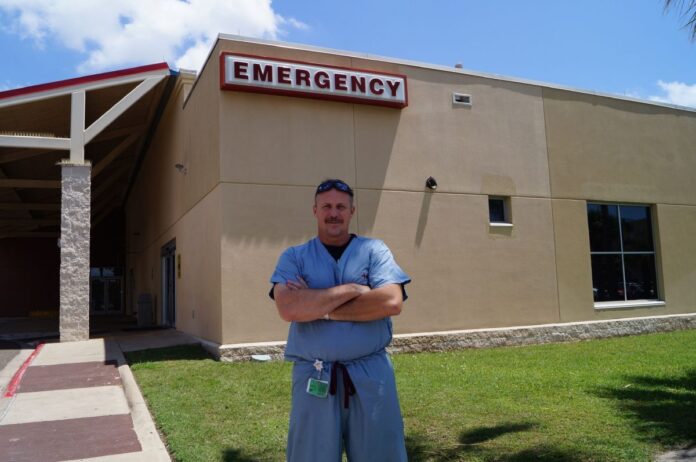HARLINGEN — It’s never good to be involved in a major accident on the expressway.
But if it has to happen, it doesn’t hurt that you’re close to a hospital.
Recently a car flipped over after hitting a concrete barrier on Expressway 77, and slid upside down for several hundred feet before coming to a stop in the grass off of the right shoulder of the expressway — just before the exit for Harlingen Medical Center.
A Harlingen Medical Center anesthesiologist, Dr. Balazs Makai, happened to be on his way into the hospital and stopped to render aid to a young Valley woman who was injured and bleeding from a laceration to her head, inside the vehicle.
Makai — along with other concerned motorists who stopped to help the young woman — was able to care for the young driver until Harlingen Emergency Medical Services arrived.
Makai said despite the severity of the accident, the young woman was able to get out of her vehicle and started to walk around.
He advised her to sit down, away from traffic.
“When something traumatic like this happens, people can become confused — and walk right into traffic, creating continuous danger for themselves and others,” he said.
A woman who also stopped to help was able to comfort the accident victim by staying close to her until EMS arrived — even though this “Good Samaritan’s” clothes become bloodied from the accident victim.
“The fact that that woman and her husband also stopped to help was wonderful, and very comforting to the victim,” Makai said. “People here in the Valley are very compassionate, compared to what I’ve seen in big cities.
“These types of accidents can happen in a spur of a moment — and any of us could be in that situation — where our life would be dependent on our fellow residents, and hopefully including a health care provider who may stop to help.”
At an accident scene, any doctor, nurse or other health care professional may suddenly find themselves thrust into a leadership role, coordinating care of the patient until further help arrives, he noted.
As a physician who assists in many surgery cases at Harlingen Medical, Makai is accustomed to the sight of traumatic injuries and bleeding.
“As health care professionals, we usually don’t panic; we think of what needs to be done next to help the patient,” he said. “That morning I walked into work with my scrubs already bloody. You never stop being a nurse or a doctor — you never stop being a healthcare provider, even after you leave the hospital and step out the door,” he added.
Rene Perez, RN, Licensed Paramedic and Director of Patient Transport Services for the South Texas Emergency Care Foundation, agreed that it’s very helpful when healthcare workers stop at the scene of an accident to render first aid and treatment in the case of life-threatening injuries — or in some cases just to help keep the patient calm — until the EMS can arrive to transport to the victim to the emergency room.
“Community involvement is so important … to have a medical professional like that stop to help is very valuable to the outcome of the patient,” Perez added.
Makai said it was amazing that the woman survived the accident, after her vehicle struck the concrete wall separating the north and southbound lanes at around 65 miles per hour.
The roof of her car was pushed down inside the car, and Dr. Makai believes the woman’s small stature — and the fact that her seatbelt kept her from flying out of the vehicle — is what helped her to survive, in spite of the severe damage to her vehicle.
“This could have been much worse,” he said. “Fortunately, I did not have to open her airway, and I did not have to stop severe bleeding. I didn’t have to do that much, but this does point out the importance of enhanced trauma services in the Valley, with traffic getting worse, and more accidents happening along the expressway.”
“Health care providers play an ultimate role in the life of a community, because you never know when someone will need us,” he added.




